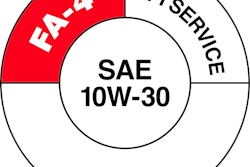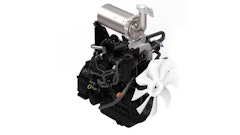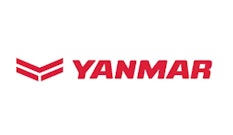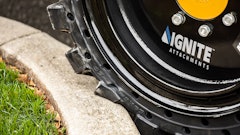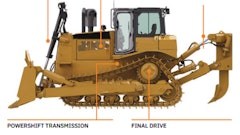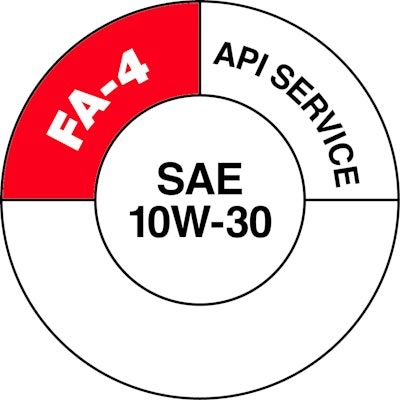
The diesel engine oil available for your fleet is about to undergo a major change. Two new oil categories, CK-4 and FA-4, have been announced by the American Petroleum Institute (API) and will replace the existing CJ-4 heavy-duty engine oil classification. You will need to understand the differences between these new oils, since they were developed to meet the diverging needs of protecting existing heavy-duty diesel engines, and providing maximum fuel efficiency for specific new engine designs. Their benefits could be different for every user, depending upon the type of equipment and how it is used.
Typically, new engine oil performance standards have emerged every four to five years. “The CJ-4 standard was first introduced in October of 2006, so it lasted 10 years,” recalls Dan Arcy, global OEM technical manager, Shell Lubricants.
During that time frame, there have been dramatic changes in diesel engine technology, which are placing greater demands on engine oil and necessitated the move to the new categories. For example, if an engine can run at a higher internal temperature, it can be more efficient and burn less fuel while producing fewer pollutants. But this requires oil with improved oxidation resistance.
The API claims CK-4 oils will be especially effective at sustaining emissions control system durability where particulate filters and other advanced aftertreatment systems are used. They are designed to enhance protection against oil oxidation, viscosity loss due to shear and oil aeration, as well as catalyst poisoning, particulate filter blocking, engine wear, piston deposits, degradation of low- and high-temperature properties and soot-related viscosity increase.
Performance and Benefit Questions of New PC-11 Oils Answered
Arcy points out three key changes between CJ-4 and the new CK-4:
- Improvements in high-temperature oxidation stability
- Improved aeration control (the ability to release air that gets entrained in the oil)
- More stringent requirements for shear stability, meaning the oil does a better job of maintaining its initial viscosity
The high-temperature oxidation stability is the most notable change. “In all my 27 years of being in the lubricants business, this is the most severe test I have ever seen,” Arcy comments.
“CITGO CITGARD engine oils will have up to 60% better oxidation resistance compared to API CJ-4, which aids in extended service intervals,” says Mark Betner, heavy duty product line manager, CITGO. Improved oil oxidation performance can help reduce piston deposit formation and increase engine rebuild life due to lower wear.
The FA-4 category is targeted to on-highway tractors. “FA-4 oils are thinner in viscosity and provide a fuel economy benefit,” says Arcy. “Over the past several years, we have witnessed a transition from 15W-40 toward 10W-30 oils for increased fuel efficiency. All major OEMs factory fill with a 10W-30 or offer 10W-30 as factory fill today.”
There are no set numbers for how FA-4 oils could impact fuel efficiency, but the move from 15W-40 to 10W-30 provides a clue. “Today, going from Shell Rotella 15W-40 to Shell Rotella T5 10W-30, we are able to substantiate a 1.6% fuel economy savings,” says Arcy. “Going from a 15W-40 CK-4 product to a 10W-30 FA-4 or a 5W-30 FA-4 product, I would expect that we will see a number that is greater than that 1.6%.”
Regulations Drive Change
A main driver of engine technology is government-mandated regulations. The associated oil technologies must keep up. For instance, CJ-4 oils were a result of the move toward the use of diesel particulate filters (DPFs) and selective catalytic reduction (SCR) to meet Tier 4 emissions standards. New regulations on the horizon are pushing oil demands beyond current CJ-4 requirements.
Stricter regulations to reduce carbon dioxide emissions and improve fuel economy in on-road diesel engines start in 2017. “In 2010, the U.S. Environmental Protection Agency (EPA) and National Highway Traffic Safety Administration (NHTSA) announced regulations to reduce greenhouse gas (GHG) emissions and mandate fuel economy improvements for medium- and heavy-duty engines and vehicles,” says Shawn Whitacre, senior staff engineer, Chevron. “The new regulations would be phased in between 2014 to 2017, imposing different fuel efficiency targets based on the size and weight of vehicle/equipment types.”
Diesel engine design is undergoing significant change to meet these requirements. Some of the more notable changes include:
- Diesel engine downsizing — many heavy-duty trucks are moving from 15 liters to 13 liters
- Down speeding — operating speeds are decreasing from 1,600 rpm to 1,200 rpm
- Advanced combustion design
- Variable valve timing
- Start/stop technology
“Diesel engine developments over recent years include engine hardware and engine operational changes,” Betner explains. “One of the most significant changes to engines includes continuous operation at higher internal temperatures, creating more stress on the engine and engine oil.”
“The Engine Manufacturers Association (EMA) in turn made a request for the API to develop a new commercial engine oil performance category to address engine oil requirements of these new engines,” says Whitacre.
But on-road regulation was not the only factor driving the demand for increased oil performance. “Off-highway benefits substantially, and off-highway OEMs played a big role in the development of this category,” Arcy points out. High-temperature oxidation stability, improved aeration control and increased shear stability were the primary requirements.
Understand the Differences
With the GHG regulations looming, manufacturers were looking for every avenue to increase fuel economy, which led to requests for a lighter viscosity grade oil and friction modifiers.
“It is recognized that engine oil can play a direct role in improving fuel economy through the use of lower viscosity grades,” notes Whitacre. “The EMA request included a proposal to introduce a subcategory with lower viscosity than allowed by previous performance categories.”
The demand for a lighter viscosity oil for improved fuel economy resulted in the split from the traditional single heavy-duty oil classification. Consequently, the CK-4 and FA-4 API categories will be two distinct oils that can’t necessarily be substituted for one another.
Designed for both the over-the-road and heavy equipment markets, CK-4 oil will be a direct replacement for CJ-4 products. “The primary difference in the two categories of heavy-duty oil is with backwards compatibility,” says Whitacre. “API CK-4 oils will support virtually all high-speed, four-stroke cycle diesel engines, including older engines that were using CJ-4, as well as new engines that are currently being developed. Use of API FA-4 oils will be OEM dependent and may not be suitable for use in older diesel engines. This category will focus on the next generation of diesel engines that are currently in development to deliver greater fuel efficiency.”
Because CK-4 category engine oils are backwards compatible with CJ-4 and API CI-4 PLUS oils, and meet the needs of new and older engines in both on- and off-highway applications, they are better suited for mixed fleets looking to utilize a single engine oil. “The improvements will deliver additional benefits to customers by enhancing engine durability and extending oil drain intervals,” says Whitacre.
Some of the oil you are currently purchasing may already be reformulated to meet the CK-4 requirement. “Although CK-4 is first licensable December 1, 2016, we will be rolling out some of our new products as early as August,” says Arcy. “They will be marketed as CJ-4 until December 1.”
FA-4 oils essentially offer the same performance benefits as CK-4 oils but with the added fuel economy benefit. “All of the tests that you have to pass for CK-4, you have to pass those exact tests for FA-4,” says Arcy. “The difference is the viscosity of the FA-4 product is lower, so they are basically thinner oils. The real challenge is to make sure there is no compromise on the durability by going to these thinner oils. We have been able to demonstrate that our FA-4 products can provide equivalent wear performance as our CK-4 products, even though they are thinner in viscosity.”
Because of its lower viscosity, FA-4 is currently not recommended for off-highway equipment. “This API category will not be suitable for use in off-road diesel equipment in the near and most likely longer term future,” says Whitacre.
“FA-4 is only recommended for 2017 and later over-the-road truck diesel engines primarily for fuel economy and will only be available in XW-30 (e.g., 0W-30, 5W-30, 10W-30) viscosity grades (no 15W-40),” Betner points out. “We expect CK-4 and FA-4 to continue to evolve as new engine technology develops.”
Three Key Traits to Look for in CK-4 and FA-4 Oils
API and Suppliers Work to Avoid Confusion
The introduction of two oil categories does add a level of complexity. “The implementation of the two engine oil categories takes time and that’s why there is a long approval, implementation and testing process, which began in 2010 with the NHTSA’s announcement,” says Whitacre. “Coupled with this process is a period of education for fleets of all sizes and owner/operators.”
The API and oil suppliers are working to ensure end users can easily identify the different products. For example, while the API’s CK-4 service symbol “donut” will look the same as the current CJ-4 donut, a special service symbol donut with a shaded section is being introduced to help consumers readily identify FA-4 diesel engine oil.
“The FA-4 donut was developed to help truck owners who need FA-4 oils easily recognize the oil and distinguish it from CK-4 oils,” says Kevin Ferrick, API’s senior manager for engine oil licensing.
Distinct labeling is also being introduced. “From a Shell standpoint, we are adding a red banner on part of the bottle and calling our products Ultra for the FA-4 products, and putting a red cap on them,” says Arcy. “We did a lot of consumer testing to see what would stand out and make it obvious to the customer.”
This product differentiation will be necessary since there will be some product overlap. “There is the possibility that at the 10W-30 viscosity grade there will be both CK-4 and FA-4 products,” notes Arcy.
It may still be possible to stock a single engine oil if you run a fleet of equipment that includes the newer truck engine technology. But the ultimate determination of what oils you are either required or allowed to use will be determined by the OEMs. There is a possibility that some truck OEMs may require FA-4 oils. “That could necessitate carrying two separate oils,” says Arcy.





